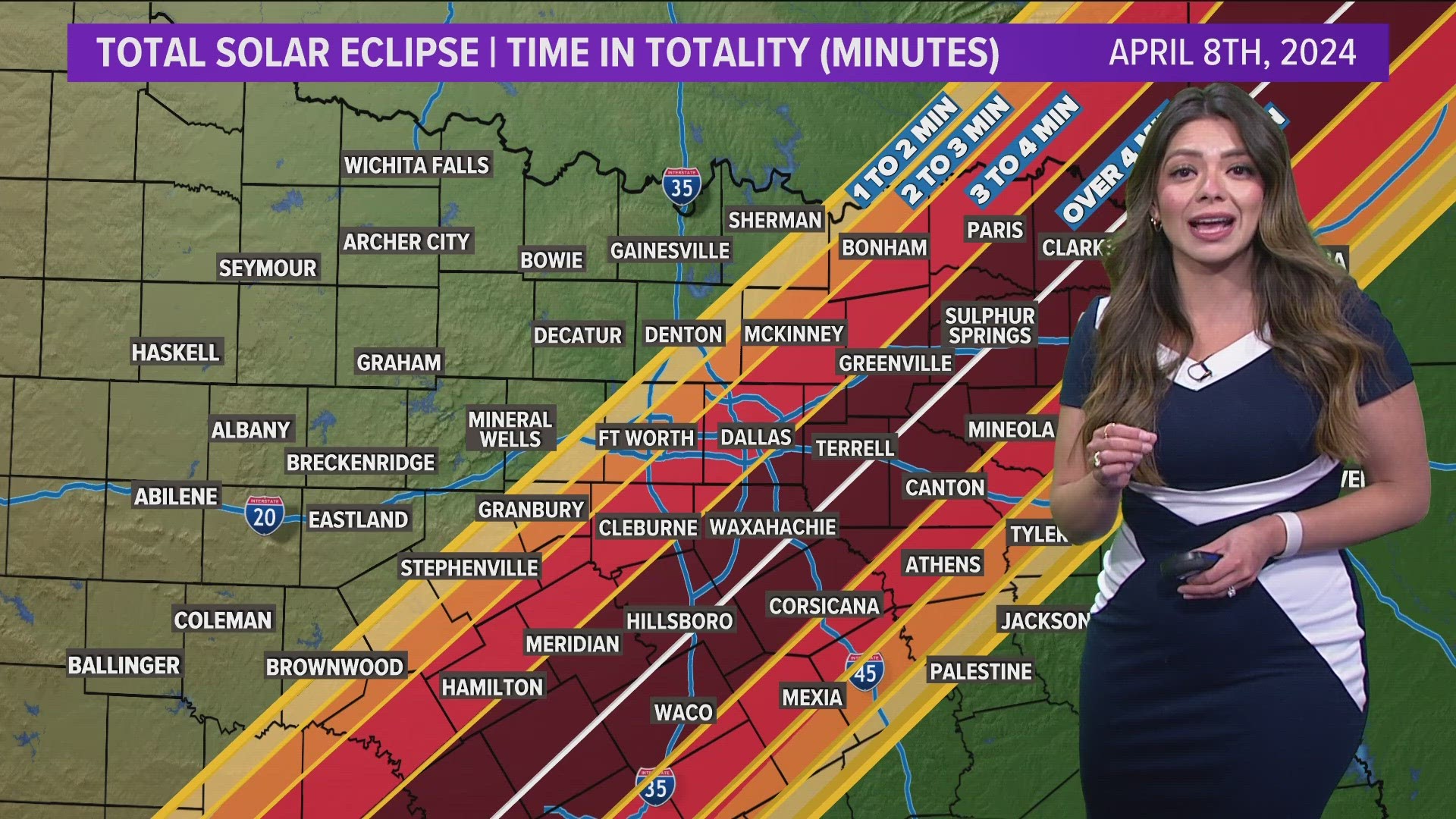DALLAS — A Total Solar Eclipse happens during the early afternoon of Monday, April 8.
All of Texas sees at least a partial eclipse, weather permitting, but some North Texas locations will be in the path of totality! The Dallas-Fort Worth area will be the largest metropolitan area in the path of totality.
What is a total solar eclipse?
A solar eclipse occurs when the Moon passes between the Earth and the Sun, completely blocking the Sun’s light from reaching Earth. This only happens during a new moon phase when the Sun and the Moon are aligned.
People located in the center of the moon’s shadow, when it is cast on Earth, experience a total eclipse. The sky will become dark, resembling dawn or dusk. As long as the sky is clear, people in the path of totality can see the Sun’s corona and the outer atmosphere which is normally not visible because of the sun’s bright face. During "totality" in a total solar eclipse is the only time it is safe to view the eclipse without the help of eclipse glasses. Unless the moon is fully blocking the sun, eclipse glasses should be worn.
There are four types of solar eclipses:
- Total Solar Eclipse: This occurs when the Sun is completely obscured by the Moon, and the Sun's corona becomes visible. Total solar eclipses are visible only from within the path of totality, a narrow track where the umbra, or the darkest part of the Moon's shadow, falls on the Earth's surface.
- Partial Solar Eclipse: In a partial solar eclipse, only part of the Sun is obscured by the Moon, this generally has a crescent shape. On April 8th, the entire continental United States will at least witness a partial solar eclipse.
- Annular Solar Eclipse: An annular eclipse occurs when the Moon is too far away from the Earth to completely cover the Sun. This results in a ring of sunlight being visible around the silhouette of the Moon. Annular eclipses happen when the Moon is near its apogee, the farthest point from Earth in its orbit. Annular eclipses are visible from within the path of moon’s shadow called the anteumbra.
- Hybrid Solar Eclipse: Sometimes an eclipse shifts from total to annular because of the Earth’s curvature. This is called a hybrid solar eclipse.
Here's a glossary of popular terms:
- Eclipse Glasses: Glasses made with solar viewing film or solar lenses that meet international safety standards for directly viewing the Sun. They should be certified to meet the ISO 12312-2 standard, indicating that they offer sufficient protection against solar radiation.
- Totality: The brief period during a total solar eclipse when the Sun is completely obscured by the Moon, allowing the solar corona to become visible.
- Path of Totality: The narrow path on Earth's surface where a total solar eclipse is visible. This path varies with each eclipse and is determined by the alignment of the Sun, Moon, and Earth.
- Umbra: The darkest part of the Moon's shadow during a solar eclipse. Within the umbra, the Sun is completely obscured.
- Penumbra: The lighter part of the Moon's shadow during a solar eclipse. Observers within the penumbra experience a partial eclipse.
- Antumbra: Part of the Moon’s shadow during an annular solar eclipse. The region of a shadow where the light source is only partially obscured. This is also the outer part of the shadow, beyond the umbra. Observers within the antumbra experience an annular solar eclipse.
- Sun’s Corona: The outer atmosphere of the Sun, visible as a faint halo around the darkened disk of the Moon during a total solar eclipse.
More Texas solar eclipse coverage:

